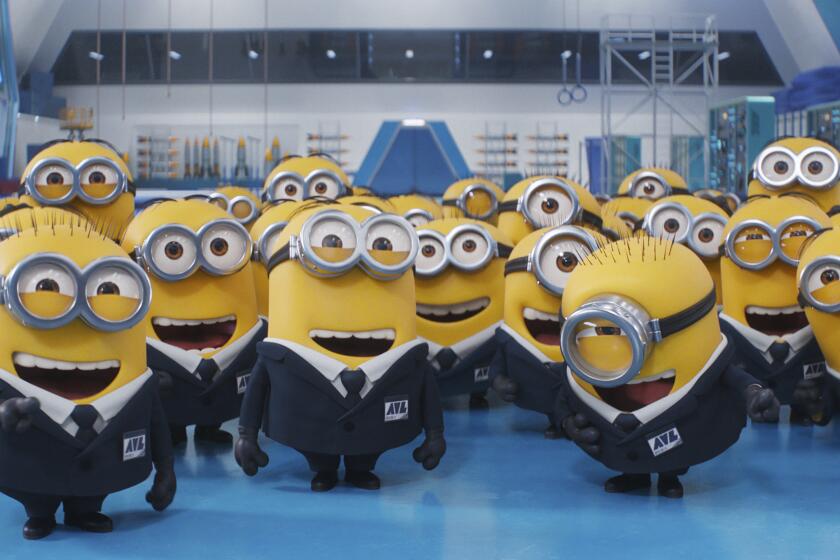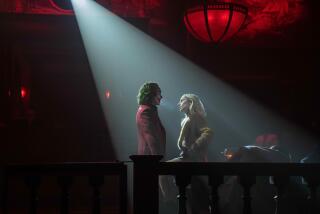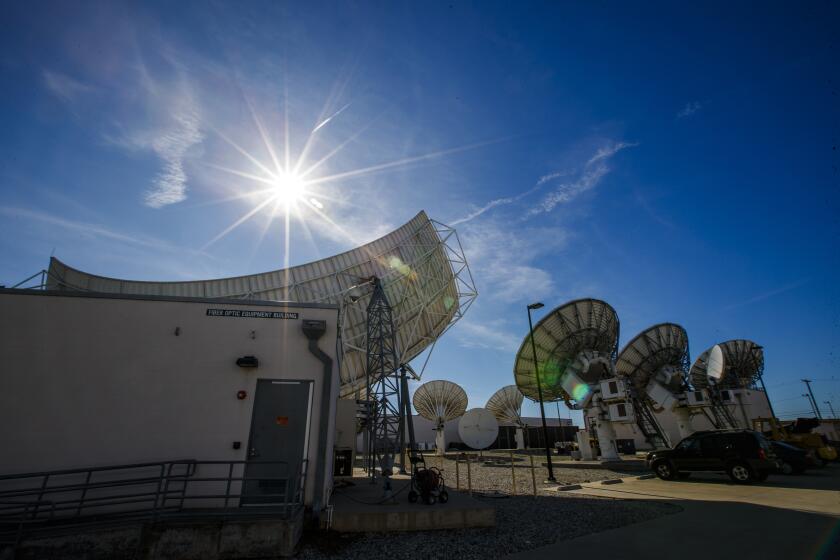Superheroes came to Hollywood’s rescue this summer. Is it enough to save movies?

Foul-mouthed superheroes, babbling Minions and plenty of Anxiety (the animated kind) have propelled this summer’s box office past the winter and spring theatrical doldrums, marking one bright spot in an otherwise industry-wide gloom.
Boosted by a bevy of sequels, the summer’s gross box office receipts (starting from the first Friday in May) is projected to total roughly $3.6 billion through the Labor Day weekend, according to Paul Dergarabedian, senior media analyst at Comscore.
That’s short of last year’s “Barbie” and “Oppenheimer”-fueled haul of $4 billion, but still higher than summer totals in 2022, 2021 and 2020 — a positive sign for theater owners and studio executives who weathered a tough January-to-May stretch of limited and underperforming films.
And with a much-anticipated fall and winter slate of films including “Beetlejuice Beetlejuice,” “Wicked” and “Moana 2,” industry insiders are sounding more upbeat for the end of the year and beyond.
“If we can carry this same momentum that we have this summer currently into the fall and then into the beginning of 2025, I think exhibition will be very pleased,” said Jim Orr, president of theatrical distribution at Universal Pictures. “We can truly say we’re back.”
The optimism is a far cry from earlier this year, when the industry collectively wrung its hands as the box office struggled to captivate audiences. That concern turned into panic by Memorial Day, when films such as “Furiosa: A Mad Max Saga” and “Garfield” did not perform up to high expectations, leading to the worst Memorial Day weekend box office in almost three decades.
(“Garfield” ended up grossing more than $257 million in global box office on a reported budget of $60 million.)
How Hollywood’s absurdly high expectations — on big-budget franchises, familiar IP, opening weekend and more — led to the current box office crisis.
Industry observers now see that five-month stretch as the low point in the theatrical slump, fueled in part by a lingering slowdown from the pandemic and the dual strikes by writers and actors, which disrupted the production and marketing of films.
“This industry took a double gut punch,” said Charles Rivkin, chairman of the Motion Picture Assn. “First we had COVID, which turned our $11-billion industry into zero overnight. And then when we were recovered from that, we immediately had the strikes.”
Morale was low at the outset of the season. Save for a few successes, such as Disney’s “Kingdom of the Planet of the Apes,” May releases — from Universal’s “Fall Guy” to Warner Bros.’ “Furiosa” — mostly fell flat.
“The expectations for ’24 were definitely tempered,” Dergarabedian said. “We didn’t have a Marvel movie kicking off the summer.”
But starting with June’s “Bad Boys: Ride or Die,” the box office started to pick up. It would be the first of several sequels to power the all-important summer box office.
Animated films helped to power the rebound.
“Inside Out 2” and “Despicable Me 4” put up blockbuster numbers, which is notable because animation was one of the slowest genres to recover from the pandemic due to families’ wariness to return to theaters and the ease of watching movies on streaming platforms.
With several animated films set for release later this year, worldwide family box office revenue could reach $6.1 billion, which would surpass 2018’s total, said David A. Gross, who publishes the FranchiseRe movie industry newsletter.
“It’s fair to say that since ‘Super Mario’ in spring of 2023, family moviegoing is back to pre-pandemic levels,” he said.
To date, the domestic box office has generated about $5.6 billion, down from $6.6 billion at this point last year, according to Comscore. But the summer box office has made up a lot of ground.
“I don’t like to spike the ball on the five-yard line, but I think we’re in the right direction,” said Rich Gelfond, chief executive of Imax Corp., the giant-screen technology company that operates out of Playa Vista. “We’re certainly on the road back.”
One reason for the recovery: Walt Disney Co. got its groove back this summer, with the help of “Inside Out 2.”
The Pixar animated sequel to 2015’s “Inside Out” drew $1.6 billion worldwide, making it the highest grossing animated title of all time, and the top movie of the summer season. Then, Disney-owned Marvel Studios packed a punch with the R-rated “Deadpool & Wolverine,” which amassed $1 billion in global revenue and became the second-highest grossing film of the summer.
“Historically, there’s been a bit of a ceiling for R-rated movies just because a bunch of kids can’t come,” said Greg Marcus, chief executive of Marcus Theatres, a Milwaukee, Wis.-based chain with about 80 locations spanning 17 states.
But the reception for the movie “speaks to the ... clamoring for product. The people are saying, ‘If you build it, we will come,’” he said
The box office showing for Pixar and Marvel was significant, as the key Disney brands have struggled to consistently deliver in recent years. The House of Mouse’s uncharacteristically weak post-pandemic track record was one reason box office analysts drastically lowballed opening weekend projections for “Inside Out 2.”
“Everyone had high hopes for that film,” said Sean Gamble, CEO of Cinemark, the Plano, Texas-based theater chain with more than 300 locations, including 20 in Southern California. “We certainly did, but that proved out to be way beyond what we expected. It’s probably one of the biggest outperforming films … we’ve seen in a very, very long time.”
Tony Chambers, executive vice president of theatrical distribution at Disney, said, “Quality matters, and quality delivers” — echoing a key point from Disney CEO Bob Iger, who has ordered sweeping cuts across the company to stem losses from its streaming business and has directed creative departments to focus on theatrical and not crank out as much content.
Appealing to broader, multicultural audiences doesn’t hurt either, Chambers said.
“It sounds very simple, but if you cast your net wide enough, the more fish you’re likely to get,” he said. “That’s been the common denominator for all the movies that have worked successfully this summer.”
Against all odds, the beloved Minions of the “Despicable Me” franchise evolved from a childhood staple to a favorite of online moms to a Gen Z icon.
To be sure, the movie industry still faces massive challenges, regardless of this summer’s slight reprieve. Box office revenue is still below pre-pandemic levels, and it’s unclear whether it will ever fully rebound as viewing habits shift.
So far this summer, theaters across the U.S. sold 274 million tickets, an 18% decline from last summer, according to industry data firm EntTelligence. That pales in comparison to the 406 million tickets sold in summer 2019 — a time when moviegoers weren’t yet accustomed to watching major releases at home on streaming services.
What’s more, film financing has become more difficult as interest rates have increased. China is no longer a reliable market for boosting American films’ box office revenue. And studios have slashed budgets and laid off thousands of employees as they struggle to balance their massive spending on streaming services with the lower-than-expected returns.
Still, if box office returns for the second half of this year are down by only 10% compared to pre-pandemic levels, that would be a good result, Gross said.
And this summer, the charge was led by a plethora of sequels.
“Sometimes people question, ‘Are there too many sequels?’’’ Gamble said. “Across the board, with compelling stories, they work. And we’ve seen many, many examples of that throughout the course of this summer.”
Of course, simply adding more chapters to a franchise doesn’t necessarily guarantee success (see: “Furiosa”). But this summer’s sequels have been “solid,” leading to some level of reassurance for the industry.
“When these things are hitting, and when the box office is flowing, it just helps everything about the business,” Gross said. “It helps everyone relax.”
While original and nonfranchise films didn’t lead the box office this year, they certainly gave it a boost.
Surprise breakout hits such as Neon’s masterfully marketed horror flick “Longlegs (the indie studio’s biggest movie to date) and Sony’s adaptation of the bestselling Colleen Hoover novel “It Ends With Us” weren’t nearly as lucrative as the likes of “Deadpool” or “Inside Out 2.” But they played an important role, exceeding expectations and keeping the popcorn lines moving.repeats “flowing” from quote.
“Every dollar counts in the summer, and those ... films added significantly to the bottom line,” Dergarabedian said. “Every $20 million times five ... is $100 million. So it all adds up to what turned out to be a pretty magnificent summer.”
Emelyn Stuart, owner of Stuart Cinema and Cafe in Brooklyn, N.Y., said summer business has been “amazing” compared to the previous year. Her theater has only one screen, which means she has just one chance at a time to pick a winner.
Last year, some of her choices included “Indiana Jones and the Dial of Destiny,” as well as the DC Comics superhero film “The Flash,” which grossed just $271 million worldwide amid a controversy surrounding its star, Ezra Miller.
This year, she chose “Bad Boys: Ride or Die,” “Despicable Me 4,” “Deadpool & Wolverine” and “A Quiet Place: Day One.” The variety of available films led to a winning combination, she said.
For the fall, she’s planning to add a second screen to expand her options — particularly for attracting family audiences.
“With ‘Wicked’ coming, with ‘Beetlejuice,’ with ‘Joker,’ I think we’re going to end the year strong,” she said.
More to Read
Sign up for This Evening's Big Stories
Catch up on the day with the 7 biggest L.A. Times stories in your inbox every weekday evening.
You may occasionally receive promotional content from the Los Angeles Times.














